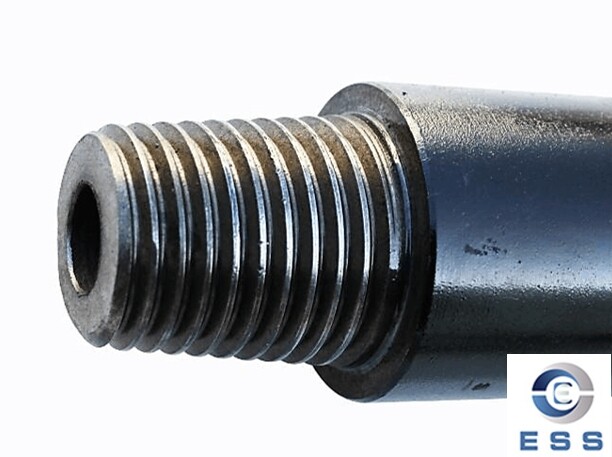
Drill pipe is a steel pipe with thread at the tail, which is a part of OCTG pipe. The
thread processing accuracy of drill pipes refers to the accuracy of the size,
shape and position of the threads after processing, which directly affects the
performance and life of the drill pipes.
Dimensional accuracy requirements
1. Outer diameter tolerance
The outer diameter tolerance of drill pipe
threads is generally between ±0.05 - ±0.15mm. For example, in some common oil drill pipe thread
processing, the outer diameter dimension accuracy requirements are strictly
controlled within a very small range. This is because the outer diameter size
directly affects the tightness of the thread fit. If the outer diameter is too
large, it will cause interference during assembly and it will be difficult to
connect with other drill pipes or joints; if the outer diameter is too small,
the connection will be loose, and it will not be able to effectively transmit
torque and withstand axial force.
2. Inner diameter tolerance
The inner diameter tolerance of the thread
is usually ±0.05 - ±0.1mm. The
accuracy of the inner diameter size is important to ensure the strength of the
thread root. Too large an inner diameter may reduce the cross-sectional area at
the root of the thread, thereby reducing its load-bearing capacity; too small
an inner diameter may affect the circulation of drilling fluid and other media
inside the drill pipe.
3. Pitch accuracy
The pitch tolerance is generally controlled
at ±0.03 - ±0.05mm. Accurate
pitch is the key to ensuring continuous and uniform thread engagement. Pitch
error will cause uneven force on the thread teeth. When transmitting torque
during drilling, it is easy to cause some thread teeth to be overloaded and
damaged, affecting the reliability of the drill pipe connection.
4. Thread length tolerance
The effective thread length tolerance is
approximately ±3 - ±5mm.
Appropriate thread length is an important factor in ensuring connection
strength. If the thread length is insufficient, it may be stripped when
subjected to large tension or torque; if it is too long, it may increase
unnecessary material costs and processing difficulties.
Tooth profile accuracy requirements
1. Tooth profile angle tolerance
The drill pipe thread tooth profile angle
tolerance is usually controlled within ±0.5°- ±1°. Taking the
common API standard thread as an example, its tooth angle is 60°, and the tooth angle error needs to be strictly controlled during
processing. If the tooth angle is inaccurate, the contact state of the thread
teeth will change, resulting in a reduction in contact area, aggravated stress
concentration, and reduced bearing capacity and sealing of the connection.
2. Tooth profile accuracy
The tooth profile should comply with the
corresponding standard specifications, such as API standards. The top and
bottom of the tooth profile should be smooth and flat, avoiding sharp edges or
irregular shapes. Because these parts are prone to stress concentration during
thread connection and force bearing, resulting in premature failure of the
thread. For the precision control of the tooth profile, it is generally
achieved through high-precision processing equipment and precise tool paths.
Surface roughness requirements
1. External thread surface roughness
The surface roughness (Ra value) of the
drill pipe external thread is generally required to be between 3.2-6.3μm. Lower surface roughness can reduce the friction during thread
connection, making assembly smoother, and at the same time, it is conducive to
the sealing material (such as thread sealing grease) to better fill the thread
gap and improve the sealing of the connection.
2. Internal thread surface roughness
The internal thread surface roughness (Ra
value) is usually also in the range of 3.2 - 6.3μm.
This helps to ensure a good fit between the internal and external threads and
reduce the possibility of wear and leakage. In actual processing, the surface
roughness is controlled by appropriate cutting parameters, tool materials and
processing technology.
Summary
The drilling pipe thread processing accuracy
requirements are extremely strict and cover many aspects. In terms of
dimensional accuracy, the outer diameter tolerance is generally ±0.05 - ±0.15mm, the inner diameter tolerance
is ±0.05 - ±0.1mm, the pitch
accuracy is controlled at ±0.03 - ±0.05mm, and the thread length tolerance is about ±3 - ±5mm. In terms of tooth profile
accuracy, the tooth profile angle tolerance is usually controlled within ±0.5° - ±1°, and the tooth profile must comply with the corresponding standard
specifications to ensure that the top and bottom are smooth and flat. The
surface roughness requirements for both internal and external threads are in
the range of 3.2 - 6.3μm. These precision requirements
ensure the sealing and reliability of the drill pipe threaded connection and
meet the performance requirements in various drilling operations.
Read more: Size of Drill Pipe or How Many Types of Drill Pipe Threads Are There?













 Eastern Steel Manufacturing Co.,Ltd not only improve product production and sales services, but also provide additional value-added services. As long as you need, we can complete your specific needs together.
Eastern Steel Manufacturing Co.,Ltd not only improve product production and sales services, but also provide additional value-added services. As long as you need, we can complete your specific needs together.










